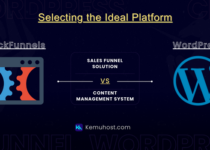The Battle of Online Conversion: Landing Page vs Website

Are you unsure whether your business needs a landing page or a website? Maybe you’re not even aware of the distinction. Don’t worry—this comprehensive guide is all you need. It will help you clearly understand these two tools and then determine the most suitable for your needs.
We’ll delve into the key differences between a landing page and a website, explore their best use cases, and weigh their pros and cons. We’ll also share tips and best practices to help you transform your landing page or website into a powerful lead generator. Let’s get started.
What’s the Difference Between a Landing Page and a Website?
A landing page and a website might look the same to some of your online visitors, but they’re not. They have different purposes and are designed for various types of user engagement. Here’s a look at the three main differences between them and how they work for your business:
- Purpose — What’s the goal?
- Content and Design — What’s in it?
- Intent — What do you intend visitors to do on your page?
- Navigation — Is there a navigation system or not?
Think of it this way—a landing page is like a single chapter of a book designed to tell a focused story that encourages the reader to take one specific action. A website will then be entire with various chapters providing a detailed overview of all aspects of the business or individual.
Don’t think of landing pages as a subset of a homepage, though. You can have stand-alone landing pages that aren’t connected to any website. A good example would be how companies might create independent landing pages for conferences, which will have a domain name and structure.
A Deeper Look at Each One’s Focus
Let’s take a deeper look at both and see what they actually do:
Landing Page
- A landing page is typically a single web page designed with a focused objective or a Call to Action (CTA). This could be to gather email addresses, sell a product, register users for a webinar, etc.
- Landing pages are designed to be simple and distraction-free. They guide visitors toward the CTA without offering navigation to other parts of a website.
- The primary goal of a landing page is to convert visitors into leads or customers, which is measured by its conversion rate.
- Typically, landing pages include less than extensive navigation like an entire website. This is to keep users focused on the primary CTA.
Website
- A website is a collection of interconnected pages under a single domain that offers a broader range of information about a business, individual, organization, etc. It includes multiple pages like “About Us,” “Contact,” “Products/Services,” and more.
- Websites are designed with a navigational structure to help visitors find information across different sections.
- While a website can also aim to convert visitors, its goals are usually more diverse, including providing information, enhancing brand visibility, and providing customer support.
- A website can be much more complex than a landing page, including a variety of content types, such as blogs, product listings, contact forms, and more.
Landing Page vs. Website: Pros and Cons

When comparing landing pages and websites, you should know each one’s advantages and disadvantages. That way, you can determine which best suits a particular marketing strategy or business goal.
Here’s an overview of the pros and cons of landing pages and websites:
Landing Page
Here are the pros and cons of using a landing page:
Pros
- Higher Conversion Rates: Because you only have one singular focus on one call to action (CTA), your landing pages can give higher conversion rates than general web pages. On average, landing pages have a conversion rate of 9.7%.
- Targeted Marketing Campaigns: You can tailor landing pages for specific marketing campaigns, audiences, or products. This results in more personalized messaging.
- Quick to Launch: Landing pages can generally be created and go live faster than a complete website. It’s a better alternative for time-sensitive promotions or A/B testing.
- Focused Analytics: With just one objective, it’s easier to measure the success of a landing page through metrics like conversion rate.
Cons
- Limited Content: The focus on a single action or message requires more space for detailed information. As a result, it might not satisfy a visitor’s intent if they’re looking for more comprehensive information like how to get in touch with you or your company’s history or background.
- Isolation: Without links to other parts of a website, users interested in exploring more about your brand or offerings cannot do so quickly.
- Multiple Landing Pages Required: Managing numerous landing pages can become complex for businesses with varied products or target audiences.
Website
Here are the pros and cons of building a website:
Pros
- Comprehensive Information: Websites allow businesses to present detailed information across multiple pages, covering various topics, products, and services.
- Brand Building: A complete website offers more opportunities for brand storytelling and establishing trust with visitors through about pages, testimonials, blogs, and more.
- SEO Advantages: With more content and pages, websites are more likely to rank in search engine results and drive organic traffic. 53.3% of all traffic comes from search, which should help you get more visitors.
- Versatility: Websites can serve multiple functions simultaneously, like hosting a blog, providing customer service information, and selling products and services.
Cons
- Higher Time and Resource Investment: Developing, launching, and maintaining a website requires more time, technical skill, and resources than a single landing page. Ensuring website security can also be more challenging.
- Potential for Distraction: More content and navigation options distract visitors from the intended conversion path.
- Lower Conversion Focus: Websites can have conversion elements, but their broader scope might dilute the focus on specific conversion goals compared to landing pages.
So Which One Do I Need?
When it comes down to it, the question is this: which one does a business need? Ideally, your business should have both. Landing pages and websites are both digital assets that could greatly benefit your business, so you should invest in creating both.
But if you’re asking which one you need for a specific project or campaign, then you’ll need to look at each one’s purpose and decide which one to use. Choosing between a landing page and a website depends mainly on your specific goals, the nature of your campaign or business, and your target audience. Here are some scenarios that outline the best use cases for each.
When to Use a Landing Page
Here are the times you should use a landing page for your business or brand:
- Product Launches or Promotions: A landing page works better if you’re introducing a new product or running a promotion. It will focus on that single offering without distractions.
- Lead Generation: Landing pages are better if you want to collect information from prospects, such as names and email addresses, for newsletters, free trials, or webinars. They offer a straightforward exchange of valuable information for visitor details.
- Event Registration: For events like conferences, workshops, or online webinars, use a landing page. It provides all the necessary details and a clear registration form in one focused location.
- Targeted Advertising Campaigns: Paid ads through platforms like Google Ads or Facebook are better pointing to a landing page. You can tailor them to the advertisement’s message and improve conversion rates by providing a cohesive experience.
- A/B Testing: Sometimes, you might want to test different marketing messages, designs, or calls to action to see what resonates best with your audience. In these cases, landing pages work better because they’re simpler to track and compare results.
When to Use a Website
And these are the times you should build a website:
- Establishing Brand Presence: A comprehensive website establishes your brand’s online presence. They provide an in-depth look at your company, values, team, and the whole catalog of your offerings.
- E-commerce: Use a website if you’re selling multiple products or services. An e-commerce platform allows customers to browse, learn, and purchase in a single space.
- Content Marketing: For businesses leveraging blogs, guides, and resources to attract and engage customers, a website provides the infrastructure to host and organize this content effectively.
- Providing Customer Support: A website can offer extensive support resources, such as FAQs, contact forms, support forums, and live chat. Customers can easily find help and solutions this way.
- Building SEO and Organic Traffic: A well-structured website with optimized content attracts organic traffic through search engines.
Best Practices When Making a Landing Page or Website
When developing landing pages and websites, applying certain best practices ensures effectiveness in achieving strategic goals. Here are some of the best practices that can get you more results for both:
1. Create Clarity in Messaging
An engaging online presence is essential for drawing in prospective students or customers, especially in fields that emphasize creativity and communication. Many institutions offering MFA degrees equip writers with advanced skills in storytelling, editing, and audience engagement, making these graduates ideal for crafting compelling content.
Ensure the content succinctly communicates your offer’s value, whether on a landing page or website. Highlighting your program’s benefits and unique aspects can effectively engage your target audience. Hire writers with online MFA degrees for writing or master copywriters to create content that converts better. With their refined skill set, MFA graduates can tailor messages to different demographics, enhancing your reach. Additionally, these professionals are trained to weave creativity into persuasive language, making your offerings stand out in a competitive digital landscape.
2. Compelling Call to Action (CTA)
A clear and persuasive CTA is crucial. It should guide users toward the following steps. Focus on one clear call to action, such as applying or requesting more information. This way, your visitors don’t get confused and proceed to the next step with less friction.
3. Always Optimize for Mobile Devices
Given the prevalence of mobile browsing, ensure your digital presence is responsive and provides a smooth experience across all devices. This is critical for reaching a wider audience.
4. Streamline Customizations
Many services help you build websites and landing pages with little to no coding. Maximize those to streamline your deployment and limit errors caused by faulty codes.
If you use WordPress, don’t hesitate to tailor themes or plugins to better suit your needs, such as incorporating specific application processes or showcasing faculty expertise. Always use a child theme when you edit WordPress code to maintain them through updates.
Driving Growth Through Web and Landing Strategies
Landing pages and websites are powerful marketing tools, but you must learn how to use them well. These principles and practices should give you as much guidance as you need. If you follow them, you could create strong funnels that drive more people to your business and bring tremendous growth.
